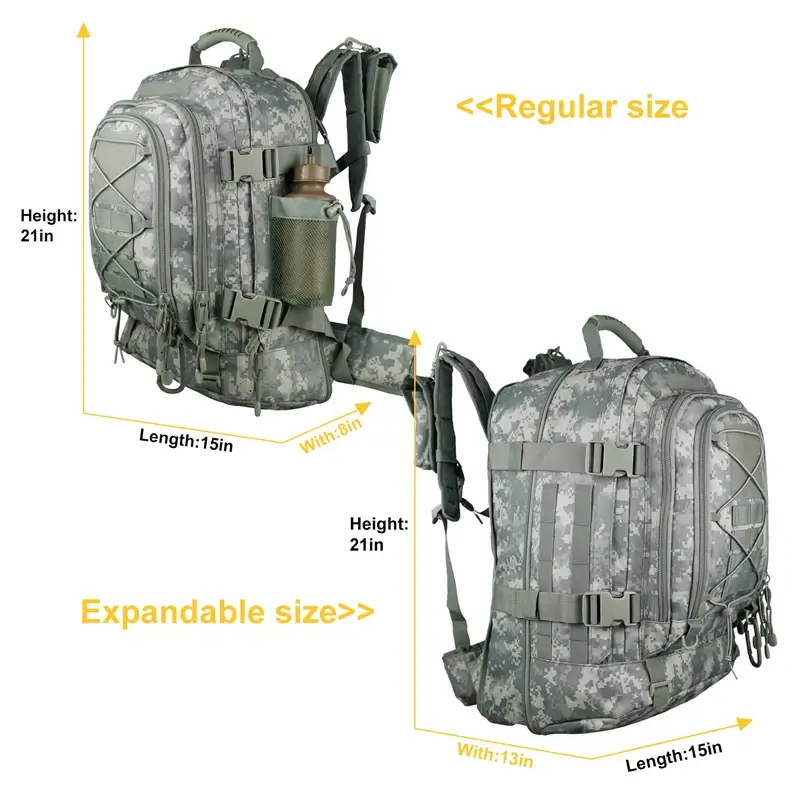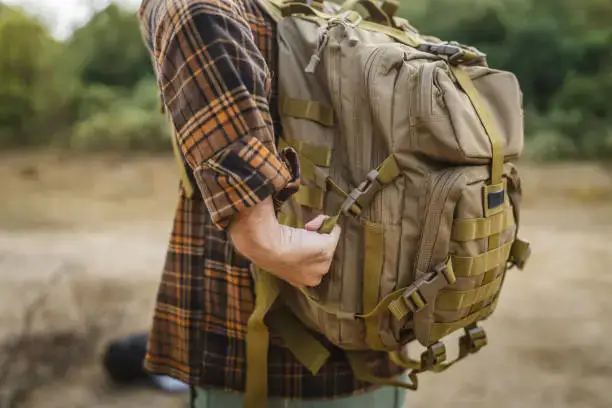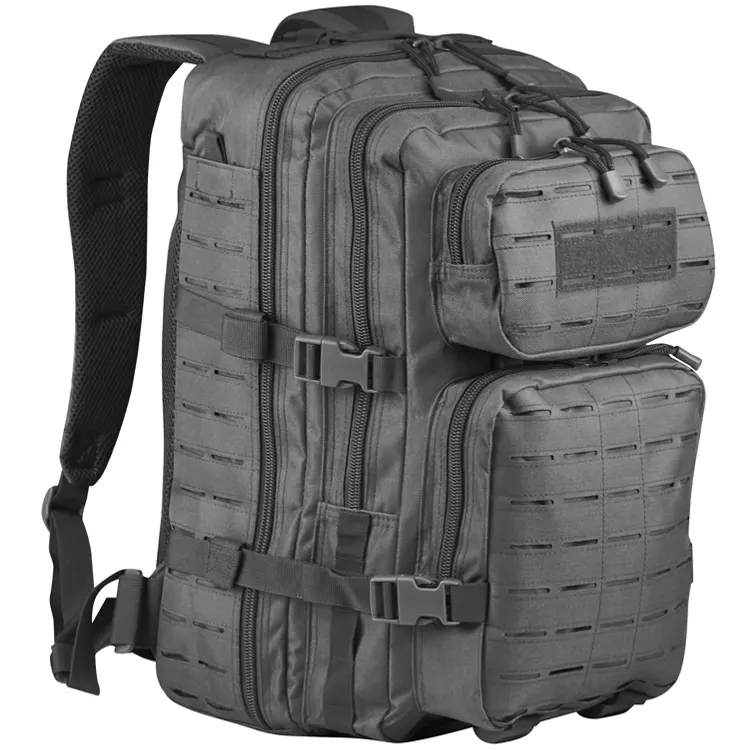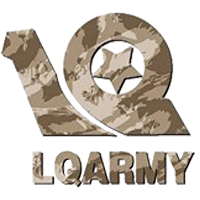With over 15 years of experience as a tactical gear manufacturer since 2009, we understand that choosing the right tactical backpack size is important for mission success. Whether supplying military units, law enforcement, or outdoor professionals, selecting the appropriate size and capacity ensures operational efficiency, user comfort, and safety.
This guide explains how to measure, calculate, and choose tactical backpacks to meet your or your clients’ specific needs while highlighting key considerations for sourcing custom solutions.
Why Tactical Backpack Size and Capacity Matter
Tactical backpacks differ from ordinary backpacks in durability, modularity, and mission-specific design. Incorrect sizing risks:
- Overloading: Strains users, reduces mobility, and increases fatigue.
- Under-packing: Insufficient space forces gear into external attachments, compromising balance and accessibility.
- Improper Fit: Causes discomfort or injury during extended use, especially in demanding environments.
For suppliers, recommending the correct backpack size builds trust, enhances client satisfaction, and minimizes returns.
How to Measure a Tactical Backpack
1. External Dimensions
- Длина: Measure from the top (base of the carry handle) to the bottom of the backpack.
- Ширина: Measure the widest point from side to side, including compression straps or side pockets.
- Глубина: Measure from the front panel to the back panel, including any external pockets.
Use a measuring tape and record the dimensions in inches or centimeters (e.g., 20″ L x 13″ W x 9″ D or 50 cm x 33 cm x 23 cm).
2. Internal Volume/Capacity
The most common method to estimate backpack capacity is a simple formula:
Volume (Liters) = Length (cm) × Width (cm) × Depth (cm) ÷ 1,000
Пример: A backpack measuring 50 cm × 30 cm × 20 cm = 30,000 cm³ ÷ 1,000 = 30 liters.
Note: This formula assumes a rectangular shape and provides an estimate of total capacity. Actual usable capacity is typically 10-20% less due to internal compartments, foam padding, curved designs, or stitching. Always consult the manufacturer’s specifications for precise usable volume.

3. Advanced Measurement Methods
While less common, the following methods can provide accurate volume measurements for irregularly shaped backpacks:
- Water Displacement: Fill the backpack with water and pour it into a graduated container to measure volume. This method is messy and rarely used in professional settings.
- Packing Peanuts: Fill the backpack with packing peanuts, then empty them into a measured bin. This is time-consuming and impractical for most suppliers.
- Приложения для 3D-сканирования: Tools like Polycam или Scandy Pro can scan irregular shapes for precise volume calculations, ideal for custom designs.
For most sourcing needs, rely on manufacturer-provided specs or the standard formula for efficiency.
Tactical Backpack Size Chart (Liters & Use Cases)
Tactical backpacks vary in size to suit specific missions and user groups. The table below outlines common capacities and their applications.
| Пример использования | Capacity (Liters) | Основные характеристики | Typical Users |
| Повседневное ношение (EDC) | 10-25L | Slim profile, quick-access pockets, laptop sleeve | Civilians, urban commuters |
| Day Missions/Hiking | 20-40L | Hydration sleeve, MOLLE webbing, lightweight frame | Law enforcement, outdoor enthusiasts |
| 72-Hour Operations | 40-60L | Load-bearing hip belt, internal frame, durable zippers | Military, first responders |
| Extended Deployment | 60-100L+ | Modular attachments, rugged materials, large main compartment | Military, expedition teams |
Примечание: Empty tactical backpacks typically weigh 3-8 lbs for 30-50L packs, depending on materials like 500D or 1000D Cordura®. Balance capacity with weight to ensure user mobility.

Key Design Features Affecting Capacity
Several design elements influence a tactical backpack’s usable capacity and suitability for specific missions:
- MOLLE/PALS Webbing: Allow attachment of pouches, but may reduce internal space due to stitching or added bulk.
- Компрессионные ремни: These stabilize loads and prevent shifting, but limit maximum volume when tightened.
- Internal Frames: Frames provide structure for heavy loads but reduce capacity by 1-3 liters.
- Гидратационные рукава: These sleeves accommodate water bladders but reduce main compartment space.
- Multi-Compartment Layouts: Separate compartments improve organization but decrease the main cavity’s usable volume.
Пример: A 40L backpack with a rigid frame and hydration sleeve may offer only 33-35L of usable storage due to these features.


FAQs: Tactical Backpack Sizing
1. Как перевести кубические дюймы в литры?
Divide cubic inches by 61.024. For example, 2,000 cubic inches ÷ 61.024 ≈ 32.8 liters.
2. What size is carry-on compliant?
Most airlines, per IATA guidelines, allow a maximum of 22″ x 14″ x 9″ (55 x 35 x 23 cm), including handles and wheels. Check specific airline policies, as international and domestic rules may vary.
3. How do I measure torso length for proper fit?
To ensure a comfortable fit:
Locate the C7 vertebra (the prominent bump at the base of your neck).
Find the iliac crest (the top of your hip bone).
Measure the distance between these points using a flexible tape measure.
Match the measurement to the backpack’s size range (e.g., Small: 15-17″, Medium: 17-19″, Large: 19-21″).
4. Can I add capacity externally?
Yes, MOLLE-compatible pouches can expand capacity, but they add weight and bulk, potentially affecting balance. Use sparingly for critical gear.
Custom Tactical Backpacks: Sourcing Solutions
В качестве производитель тактического снаряжения with over 15 years of experience, we specialize in producing high-quality, настраиваемые рюкзаки tailored to clients’ needs. Our capabilities include:
- Custom Dimensions: Design backpacks to fit specific gear, such as radio panels, body armor plates, or medical kits, ensuring optimal space utilization.
- Material Optimization: Use durable yet lightweight fabrics like 500D or 1000D Cordura® or ballistic nylon to balance capacity, weight, and durability.
- MOLLE Layout Engineering: Strategically place webbing to maximize attachment options without compromising internal space or structural integrity.
- Обеспечение качества: Adhere to standards, such as ISO 9001, for consistent quality in bulk production.
- Варианты устойчивости: Offer eco-friendly materials, like recycled polyester, to meet growing demand for sustainable tactical gear in 2025.
- Преимущества оптовых заказов: Provide cost-effective pricing, branded customization (e.g., logo embroidery) for large orders.
Заключение
Understanding tactical backpack sizes, dimensions, and capacity calculations ensures you source gear that meets real-world demands. Prioritize accurate measurements, mission-specific volumes, and scalable customization.
Need a bulk order of tactical backpacks with tailored sizing? Contact us for customized solutions that meet your specifications.


